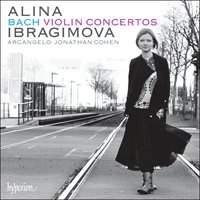Texte paru dans: / Appeared in: |
|
| "Urgently recommended" |
Outil de traduction ~ (Très approximatif) |
|
Reviewer: Robert
Maxham A historically informed performance, or, as the booklet suggests, one that transcends the movement? Violinist Alina Ibragimova and the ensemble, Arcangelo, present Bach’s violin concertos, canonical and reconstructed alike, in well-scrubbed textures and the relaxed string tension that lower pitch entails. She’s sprightly in the familiar A-Minor Concerto’s opening movement, teasing rather than probing in its Andante, and almost dances on air over the ensemble’s transparent (though, at times, crunchy) textures in the finale. This kind of froth makes clear just how much Bach’s idea of the violin concerto derives from Vivaldi, but the performers never indulge a hint of irreverence or even of superficial penetration. She and the ensemble achieve a similar effect in the E-Major Concerto, whipping the first movement’s bariolage until it bristles, while the bass line bounces along cheerfully. Ibragimova’s violin, made by Anselmo Bellosio around 1775, provides in this movement a gentle foil to the orchestra’s bright timbres. Ibragimova introduces a great deal of nuance into the slow movement’s solo line without succumbing to distortion or even to mannerism. The finale sounds so dance-like in her reading that some may wonder why others violinists haven’t discerned a similarly blithe spirit in it. The rest of the program consists of reconstructions, beginning with the Concerto in A Major, BWV 1055, developed from the A-Major Harpsichord Concerto bearing the same number. Richard Wigmore’s notes report that the same concerto has been identified, as early as in writings by Donald Tovey, as having itself derived from a concerto for oboe d’amore; this origin might explain the solo part’s low tessitura. In the slow movement, Ibragimova twists her sinuous lines seductively around the balder orchestral statements; and her reading of the finale bustles with exuberant energy. The second reconstruction, that of the Keyboard Concerto in F Minor, BWV 1056, comes with the pitch of the original raised a whole step (in this case, to G Minor), then lowered, to our ears, nearly a half step (with the pitch close to A=415). Ibragimova sounds downright plaintive, her relatively straight, vibrato-less tone enhancing interpretatively the native timbre of her instrument. Her violin sounds almost viola-like, though hardly rich, in the finale. The Concerto in D Minor comes from the Keyboard Concerto in D Minor of the same number, BWV 1052. Ibragimova enlivens the first movement’s complex passagework, and plays the cadenza-like passage with earthy vigor. She’s more severe in the slow movement, but returns with greater élan in the finale.
The engineers have placed
their soloist in the midst of, rather than in front of, the orchestral
sound, which has been enlivened by the addition of lute, the activity of
which often brings a sense of movement to the performance that some
listeners may find surprising. There’s been no lack of recent pairings of
Bach’s familiar concertos with reconstructions. While those who expect a
soloist, even in Baroque concertos, to appear in front of the ensemble, at
least aurally, may miss the aggressive soloistic posture of Isaac Stern in
these concertos, those who view them primarily as chamber music will have to
look far and wide even among her closest competitors for a similar
combination of playfulness and energy. Finally, to answer the review’s
opening question: Ibragimova’s performance transcends fads and passing
preferences. Urgently recommended. | |
|
|
|
|
Cliquez l'un ou l'autre
bouton pour découvrir bien d'autres critiques de CD |
|




